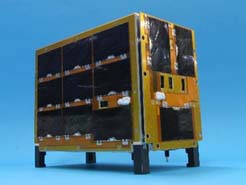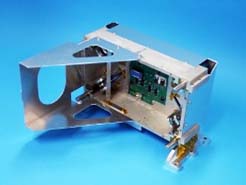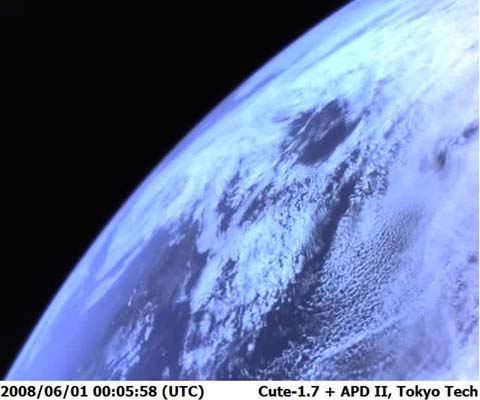[[Series 2: PSLV Successfully Launched Ten Satellites]]
- Cute-1.7 + APD II, Tokyo Institute of Technology, Japan -
Dr. Matsunaga Saburo, Associate Professor, Department of Mechanical and Aerospace Engineering, Tokyo Institute of Technology
Cute-1.7 + APD II is a nanosatellite weighing 3 kg and with a volume of 10 cm ?? 15 cm ?? 20 cm that was developed by the Matsunaga Laboratory in the Department of Mechanical and Aerospace Engineering at the Tokyo Institute of Technology. We completed this satellite after improving it using the results of the development and operations in orbit of the former satellite Cute-1.7 + APD.
This satellite is the third one we have developed. CUTE-I was our first nanosatellite, and was the first satellite in the world to be launched and successfully operated that weighed 1 kg and had a volume of 10 cm ?? 10 cm ?? 10 cm . The second satellite was the engineering verification satellite, Cute-1.7 + APD.
ISRO's Polar Satellite Launch Vehicle, PSLV-C9, successfully launched the 690-kg Indian remote-sensing satellite CARTOSAT-2A, the 83-kg Indian Mini Satellite (IMS-1) and eight nanosatellites for international customers (from six countries, including Cute-1.7 + APD II and SEEDS 2 from Japan at 12:53:51 (Japan time) on April 8, 2008 from the Satish Dhawan Space Centre (SDSC) in the south of India, and all 10 satellites were safely injected into a 637-km polar Sun Synchronous Orbit (SSO).
Cute-1.7 + APD II was launched from the Satish Dhawan Space Centre onboard a PSLV-C9 rocket at 3:53.51 a.m. (UTC) on April 28, 2008. At present, it is in a Sun Synchronous Orbit with an inclination angle of 98.0 degrees, a period of 97.2 minutes, an apogee altitude of 635 km and a perigee altitude of 615 km. The initial checks have been completed and it is now in its initial operation phase. This marks the third time running that the Matsunaga Laboratory has successfully launched and operated such satellites in orbit.

Fig. 1 Cute-1.7 + APD II

Fig. 2 An exclusive separator
Cute-1.7 + APD II is a successor to Cute-1.7 + APD, which was launched by the Japanese rocket M-V-8 in February 2006, and it has been improved in various ways. For example, it has been fitted with countermeasures for cosmic rays, which affected the former satellite. The missions of this satellite are:
1) Verification in orbit of the satellite bus devices using commercially available electronic devices such as PDAs.
2) Verification in orbit of the ADP (Avalanche Photo Diode) sensor, a new detector for cosmic rays.
3) Implementation of three-axis attitude determination and experimentation of attitude control by using only a magnetic torquer.
4) Providing amateur radio services all over the world.
5) Verification in orbit of the nanosatellite separator system.
Figure 3 shows an image of the Earth, the first image captured and downloaded by the CMOS camera onboard Cute-1.7 + APD II. Among other things, the Kanto Plain of Japan (Tokyo area) and clear images of the clouds on Earth are visible.
Fig. 3 The first image from the CUTE-1.7 + APD satellite

Figure 4 shows the distribution of low-energy charged particles (with an energy of 15 keV or more) at an altitude of 620 km, measured using the APD sensor, which was developed by the Kawai Laboratory in the Department of Basic Physics at the Tokyo Institute of Technology. In general, it is said that because of noise it may be impossible to observe charged particles with an energy of less than 30 keV using a normal PD (photo diode) sensor.

Researching and developing a nanosatellite is the ultimate practical education and has the possibility of allowing the developer to actually acquire experience in manufacturing, system engineering and project management. And also it has the high scientific value that the developer may possibly develop and verify in orbit some leading space engineering technology in a short cycle, and give the developer an outlook on space.
In the future, we would like to develop our capacity building and the cooperation among various fields in industry, government and academia, aiming to find and develop things in the fields of new space engineering and business, as well as conducting early orbit verification on the parts level, and implement beneficial scientific and practical missions using a nanosatellite or a group of satellites.
Finally, we greatly appreciate the tremendous support we were given, such as the funds we received from the Ministry of Education, Culture, Sports, Science and Technology to cover the expenses of satellite development; the funds we received from the JAXA open laboratory and the president of the Tokyo Institute of Technology to cover the launching expenses; the COE funds we received to cover the expenses of the mechanical system; and the graduate education reform funds we received.
Related websites:
Cute-1.7 + APD II: http://lss.mes.titech.ac.jp/ssp/cute1.7/index_e.html
Cute-1.7 + APD II project weblog: http://lss.mes.titech.ac.jp/ssp/cute1.7/blog/
Matsunaga Laboratory: http://lss.mes.titech.ac.jp/index_e.html
Kawai Laboratory: http://www.hp.phys.titech.ac.jp/info/index.html
UTIAS-SFL NLS-4: http://www.utias-sfl.net/NLS-4/
ISRO: http://www.isro.org/
PSLV-C9: http://www.isro.org/pslv-c9/index.htm